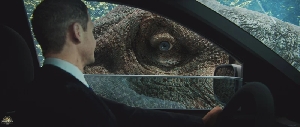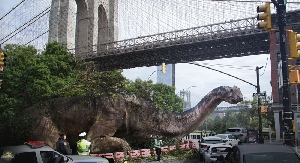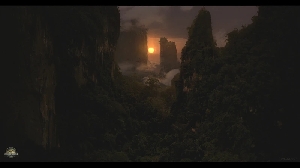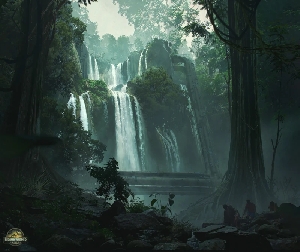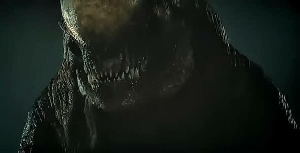Were Dinosaurs Really Terrible Lizards
Dinosaurs Forum Topic

Gavin
MemberTyrannosaurus RexAug 20, 20137140 Views19 RepliesAs with any self respecting geek or nerd I have been a Dinosaur fan since I was a little boy; I even had (once upon a time) quite a collection of Dinosaur books, mostly written in the 70's and 80's. Despite these old books affirmations by their respective "experts" that the Dinosaurs where not wiped out by a large asteroid and that Dinosaurs did not evolve into birds, I kept an open mind. And with a lot of recent scientific discoveries proving the aforementioned "experts" wrong. It got me thinking.
[u]Dinosaurs - Birds: A No Brainer[/u]
How the experts of yesteryear could deny the possibility that many small to medium sized Theropod Dinosaurs evolved in to birds defies logical belief, even the books I read as a child, written by these so-called "experts" referred to Ornithischian Hipped Dinosaurs as "Bird-Hipped" Dinosaurs. Looking at the two comparison pictures below...
[center][img]http://i.imgur.com/J3l7QQP.jpg[/img]
[i]Procompsognathus (left), Grey Egret (right)[/i]
[img]http://i.imgur.com/xRQKLZn.jpg[/img]
[i]Gallimimus (left), Ostrich (Right)[/i][/center]
[u]Feathered Dinosaurs Though, Really[/u]
Well if small to medium Theropod Dinosaurs evolved in to prehistoric and then modern day Birds, then yeah Dinosaurs would have developed feathers as part of the evolutionary process for sexual displays, warmth and inevitably (though not in all cases) flight.
[u]But Dinosaurs Where Reptiles, Birds are Warm Blooded[/u]
Yes Birds are warm blooded creatures whose only scales, if they can be called scales, are found on their feet. And no Birds are not reptiles. So one could (and in cases some scientists do) argue that birds did not evolve from Theropod Dinosaurs, for that very reason.
Or one could instead argue that the presumption that Dinosaurs (latin for Terrible Lizard) were reptiles is actually incorrect. But before you call me crazy, take a look at the following comparison image...
[center][img]http://i.imgur.com/ftMrUP6.jpg[/img]
[i](Top Left-Right) Giant Tortoise, Alligator, Komdodo Dragon.
(Bottom Left-Right) Tyrannosaurus Rex, Stegosaurus, Brachiosaurus.[/i][/center]
Notice the top 3 images, all of which are reptiles have their limbs spreading out from their sides, a common reptilian trait that allows them to remain low to the ground to absorb heat from the environment to warm their blood - all reptiles share this anatomical feature.
Yet in the lower three pictures our Dinosaurs are stood upright, much like mammals, birds and other warm blooded animals. What if Dinosaurs were actually warm blooded, and thus not Reptiles.
[u]But Didn't Dinosaurs have scales like modern day Reptiles[/u]
Well the only evidence we have to go off are a few very rare and vague fossilized impressions of Dinosaur skin, which could be scales or could be somthing entirely different.
Not all mammals are covered in fur/hair, take the Elephant, Rhinoceros, Hippopotamus, Aramdillo etc. It is possible that Dinosaurs could have had leathery, bumpy skin instead of scales, which more suits the image we have of Dinosaurs such as the Tyrannosaurus Rex, Brachiosaurus and Triceratops.
But this of course opens another can of worms - are Birds the only ancestors of Dinosaurs alive today. Maybe not. Take a look at the next comparison picture...
[center][img]http://i.imgur.com/hZ6gqWy.jpg[img]
[i]Triceratops (left), Rhinoceros (right).[/i][/center]
Lose the bone frill, shorten the tail, add a horn, and add some fat and its quite viable that Dinosaur favorite the Triceratops may have evolved into the modern day Rhinoceros.
So if Dinosaurs weren't cold blooded, of which the physical evidence seems to suggest, and if their skin was leathery instead of scaled, and as such they were not reptiles, what where they.
Well unless the scientific community wants to create a new genus for them, they were mammals. Think of the Plesiosaur, a marine reptile according to the Dinosaur rulebook, yet it possessed a smooth skin similar to that of a hippopotamus or Dolphin, and breathed air. In Fact take a look at the next comparison picture...
[center][img]http://i.imgur.com/RfYINoa.jpg[/img]
[i]Did the Ichthyosaurus (left) evolve into the Dolphin (right)[/i][/center]
Where Dinosaurs Reptiles or Mammals, or something else? What do you think? And while your at it take a look at this final image...
[center][img]http://i.imgur.com/5gyd8JH.jpg[/img]
[i]Which animal is the drawing emulating?[/i][/center]
The top image is a drawing of an animal in which the head and tail have been erased, but is it a drawing of an Elephant (bottom left) or a Brachiosaurus (bottom right), look carefully, very carefully before answering - I will reveal the answer in due course.
Replies to Were Dinosaurs Really Terrible Lizards
Hey Guest, want to add your say?
Are you an avid Jurassic World fan looking for a dedicated online community of likeminded fans? Look no further! Create your own profile today and take part in our forums and gain XP points for all the content you post!







